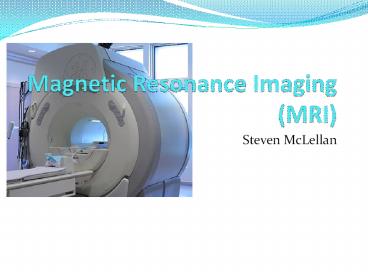Magnetic Resonance Imaging (MRI) - PowerPoint PPT Presentation
Title:
Magnetic Resonance Imaging (MRI)
Description:
Evaluates the arteries of the neck and brain, ... Constantia Arial Calibri Wingdings 2 Flow 1_Flow 2_Flow 3_Flow Magnetic Resonance Imaging (MRI) What is MRI? ... – PowerPoint PPT presentation
Number of Views:190
Avg rating:3.0/5.0
Title: Magnetic Resonance Imaging (MRI)
1
Magnetic Resonance Imaging(MRI)
- Steven McLellan
2
What is MRI?
- Produces very clear, detailed pictures of the
organs and structures in the body - It is a form of medical imaging that uses no
Ionizing radiation - MRI makes use of the property of Nuclear magnetic
resonance (NMR) to image nuclei of atoms inside
the body.
3
History
- The first MR image was published in 1973
- The first studies performed on humans were
published in 1977 - Created by Dr. Raymond V. Damadian, Dr. Larry
Minkoff and Dr. Michael Goldsmith - In 2003, The 2003 Nobel Prize in Physiology or
Medicine was awarded to Paul C Lauterbur and
Peter Mansfield - Made new MR imaging techniques
- Faster and more efficient
4
Common Uses
- Physicians use the MR examination to help
diagnose or monitor treatment for conditions such
as - Tumors and other cancer related abnormalities.
- Certain types of heart problems.
- Blockages or enlargements of blood vessels
- Diseases of the liver, such as cirrhosis, and
that of other abdominal organs. - Diseases of the small intestine, colon, and
rectum
5
Common Uses
6
How does it work?
- An MRI machine uses a powerful magnetic field to
align the magnetization of some atoms in the
body. - radio frequency fields systematically alter the
alignment of this magnetization - This causes the nuclei to produce a rotating
magnetic field detectable by the scanner - This information is recorded to construct an
image of the body.
7
How does it work?
8
How does it work?
- Images are constructed when protons in different
tissues return to equilibrium state at different
rates. - Five variables effect these rates
- Spin Density Concentration of nuclei in tissue
processing in a given region under a magnetic
field. - T1 Longitudinal relaxation time
- T2 Transverse relaxation time
- Flow Shows blood flow, CSF flow
- Spectral Shifts Angle/zoom the picture is taken
from.
9
Basic MRI Scans
- T1-weighted Differentiate fat from water
- Water is Darker, fat is brighter
- Provide good gray matter/white matter contrast in
brain. - T2-weighted Differentiate fat from water
- Fat shows darker, and water lighter.
- Good for imaging edema
- Abnormal accumulation of fluid beneath the skin
or in one or more cavities of the body
10
Common Uses
11
Common Uses
12
Specialized MRI Scans
- Diffusion MRI
- Measures diffusion of water through biological
tissues. - Diffusion may be anisotropic (unequal physical
properties along different axes) - Diffusion Tensor Imaging (DTI)
- Examine areas of neural degeneration and
demyelination in diseases such as Multiple
Sclerosis (MS)
13
Diffusion MRI
14
Specialized MRI Scans
- Magnetic resonance angiography (MRA)
- Generates pictures of arteries.
- Evaluates the arteries of the neck and brain, the
thoracic and abdominal aorta, the renal arteries,
and the legs - Uses gadolinium injection as paramagnetic
contrast agent - Magnetic resonance venography (MRV) is a similar
procedure that is used to image veins.
15
Magnetic Resonance Angiography
16
Safety Risks
- MRIs create up to 120dB
- Equivalent to jet engine at take off.
- Contraindications
- Pacemakers, Vagus Nerve Stimulators, implantable
defibrillators, insulin pumps, deep brain
stimulators - Any electronic or magnetized foreign bodies
(surgical prosthesis) - Peripheral nerve stimulation (PNS)
- Rapid switching on and off of the magnetic field
gradients is capable of causing nerve stimulation
17
During Procedure
- People hold the part of their body being scanned
motionless for 30-60 minutes. - Procedure is done in multiple parts.
- Takes time to switch between different scans and
fields of view.
18
Future?
- More detailed images
- All MRIs use color?
- Better pictures of bone structures
- Shift from x-rays and CT scans to MRI
- New Scanning sequences
19
Citations
- Dyson, Sue J. Magnetic Resonance Imaging.
Philadelphia, PA Elsevier, 2007. Print. - Hashemi, Ray H., William G. Bradley, and
Christopher J. Lisanti. MRI the Basics.
Philadelphia, PA Lippincott Williams Wilkins,
2010. Print. - "Magnetic Resonance Imaging (MRI) - Body."
RadiologyInfo - The Radiology I nformation
Resource for Patients. Radiological Society of
North America, Inc., 15 Mar. 2010. Web. 06 Mar.
2011. lthttp//www.radiologyinfo.org/en/info.cfm?p
gbodymrgt. - Radiology". http//radiology.rsna.org/content/204/
1/272.long. Retrieved 2 August 2010. - Westbrook, Catherine. MRI. John Wiley Sons,
Incorporated, 2009. Print.































